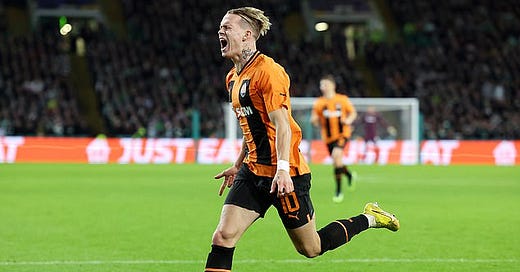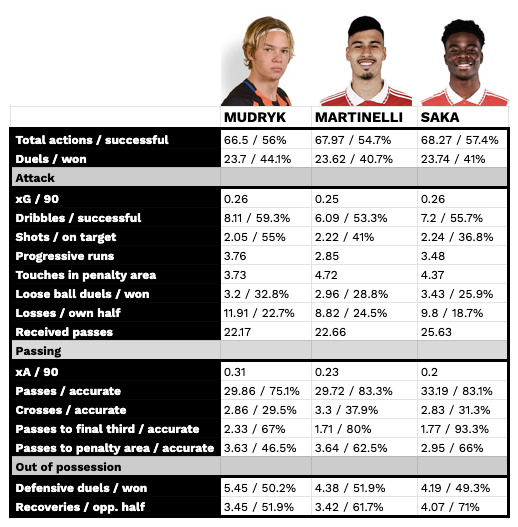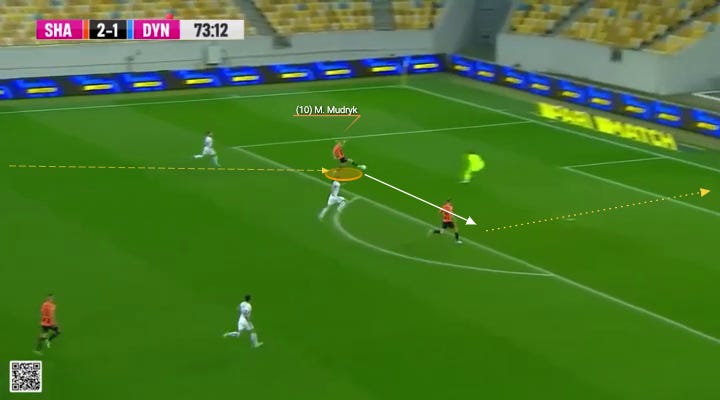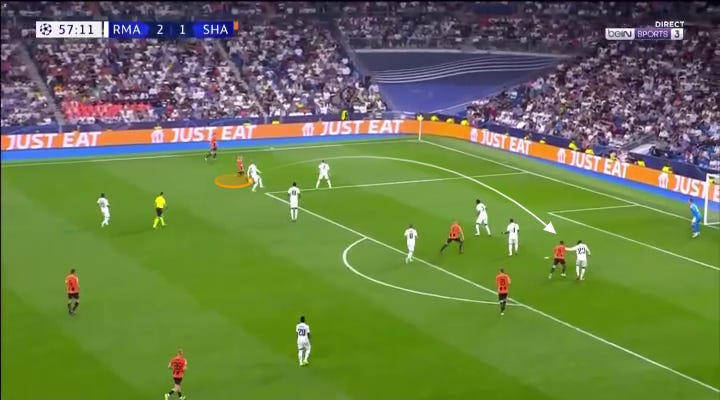Let's explore Mykhailo Mudryk's game in depth
Behold, an overzealous examination of the Ukrainian star's body of work to better understand his skills and trajectory ahead of a potential move
When Pep Guardiola came to Manchester City in 2016, there was a player waiting for him. Raheem Sterling had been signed the year prior for a £50m transfer fee, the highest paid for an English player at the time, “specifically in anticipation of Pep taking over.”
After a personally disappointing debut campaign under outgoing coach Manuel Pellegrini—resulting in six league goals, injury, and time spent out of the starting lineup down the stretch—the newly-arrived staff faced the task of helping Sterling reach his potential.
Enter Mikel Arteta. In the years to come, he was reportedly the coach who worked most closely with Sterling, using a hands-on approach to improve his positioning, confidence, and shot selection. Guardiola considered the project one of Romário-fication, referring to his old teammate who was the recipient of his passes on the half-turn at Barcelona.
Gradually then suddenly, Sterling transformed himself into one of the world’s most effective wingers—combining dizzying speed with a relentless, flexible approach to positioning that resulted in three consecutive 20-goal seasons in a system that played to his strengths. Meanwhile, his colleague Leroy Sané posted 25 league assists in a two-year span. Said Sané:
“People always ask me about training under Pep, but the things I’ve learnt from Mikel Arteta! We get on brilliantly, he’s a lovely guy and a great coach. And he’s always right.”
Now with Arsenal, Arteta has continued his winger-whisperer ways, coaching along stellar campaigns by Gabriel Martinelli and Bukayo Saka, while being reunited with another flexible attacker from his City days in Gabriel Jesus.
In the middle of a title charge, Arsenal may be looking to add another option to the fold in Mykhailo Mudryk. What can he bring to the team? Would he begin as pure depth or as a legitimate level-raiser? Can Arteta work his magic again?
Let’s dig in.
🤔 Why are we talking about Mudryk?
Mykhailo Mudryk is a left-winger currently playing for Shakhtar Donetsk. A supersonic 21-year-old with some of the best YouTube compilations around, Mudryk had attracted approaches from the likes of Brentford, Everton, and Bayer Leverkusen over the summer—as well as reported interest from Arsenal.
Since then, Shakhtar has publicly raised a price of €100million—do you, Shakhtar—but there are recent reports that the ask is likely down to around £40m plus potential add-ons, with Mudryk hinting that an Arsenal move may be his preference.
What’s true? Who knows—but there’s plenty of smoke, with Fabrizio Romano reporting his understanding that Arsenal’s priority is “still Mudryk.”
Which leads us to this piece. In the interest of showing work: since 2021, I’d seen Mudryk in a few Champions League clashes, starting with the games against Real Madrid and Ajax last year. This year, I’d also seen him in a few Champions League games (Leipzig, Celtic, Real Madrid), and for this, I buttressed that with some in-league watching, including games against Metalist 1925 Kharkiv, Vorskla, and Dynamo Kyiv. I also went back and watched one of the Real Madrid games (I had it on in the background, more accurately), and rifled through clips and highlights throughout the year. There are still likely to be blindspots. Where they are, fill them in!
Below are the results of all that.
🤔 What is his positioning and play-style for Shakhtar?
Over the years, Shakhtar has come to be known as an ample proving ground for talented Brazilians to raise their trajectories, seeing the likes of Fernandinho, Douglas Costa, Willian, and Fred pass through their ranks before transitioning to top-5 sides.
After climbing the youth system with a sense of speed and flair that would look right at home in the Brasileirão, Mudryk saw his first brushes with significant Shakhtar playing time last year under current Brighton skipper Roberto De Zerbi. He was used wide-left in a variety of shapes, his talent starting to shine through in a season that was abridged due to the Russian invasion of Ukraine.
Under the leadership of current coach Igor Jovićević, the team has almost entirely featured in a 4-1-4-1 system. Here’s a look at a standard lineup, with Mudryk’s heatmap across competitions next to it:
In this shape, Mudryk is generally tasked with starting wide near the halfline and calling upon his bag of tricks: playing 1-2s, sprinting for throughballs, or his favorite: beating the opponent 1v1 on the dribble. While he interchanges with central players a bit, he’s generally at home on the left before cutting in, and has played exclusively over there in the last two years. (In his entire career, he's played on the right for 955 minutes, or about ~10.5 games, but that goes back to his U17 days. Seeing similar time in the middle: 940 minutes in all. It’s been a while, though.)
While most famed for his exploits on the counter in the Champions League, Shakhtar’s style changes considerably in league play. Their possession rises from 43.73% in the Champions League to 62% in Ukraine, while their PPDA gets cut in half: going from 20.87 passes per defensive action to 9.33.
What does that mean? It means that Shakhtar parked a bus in the Champions League, but otherwise, they’ve played at a higher rate of possession and with a higher intensity line than Arsenal this year. Mudryk’s style adjusts accordingly, as being a mere “counter merchant,” as the kids say, won’t do.
🔴 How does he compare to Arsenal’s current starting wingers?
Below, I’ve pulled the numbers for Mudryk, Martinelli, and Saka across competitive fixtures this year, which includes league play—plus Europa League for Arsenal and Champions League for Shakhtar.
As always, massive caveats apply: Saka plays on the right; the teams play different systems; the gap in level of play between the Ukrainian Premier League and the English Premier League is stark. That said, the gap in the total data may not be quite as wide as one may initially think; Mudryk’s sample includes 960 minutes domestically and 532 in the Champions League, with multiple matchups against the likes of Real Madrid, Leipzig, and Celtic.
With all that said, this comparison should give us a broad sense of understanding about playing style:
Some notes, with those caveats in tow:
There are a lot of broad similarities in profile.
Mudryk’s dribbling stats—both quantity and success rate—would currently place him among the league leaders in the Premier League.
His shots are much more likely to be on target; he’s marginally more likely to complete a progressive run, but less likely to get touches in the penalty box. He also loses the ball a bit more.
Two surprises for me: upon eye test, thought Mudryk’s crossing stats would be a bit higher, and I’m surprised he initiates more defensive duels than the Arsenal dudes.
Just a side note: Saka passing to the final third at a rate of 93.3% is ridiculous.
🤔 Is he as fast as they say?
In so many words: fuck yeah. There are understandable concerns about league quality and whether he’d be able to consistently blow past top players, but those are quickly disabused by the tape. He has a reasonable claim as one of the fastest players anywhere in the world today. Exhibit A:
The speed he reached (36.6 km/h) would also match the fastest in the Premier League this season: equal with Anthony Gordon and above the likes of Nunez, Haaland, and Martinelli.
Granted, top speed does not tell the entire story of game speed, but his version does apply to the match itself, with Mudryk keeping pace or passing the likes of Valverde and Rudiger on sprints to loose balls.
Perhaps most impressive is that he knows how to modulate his acceleration, which is something that players usually layer in with time. He’s already got the tricky Messi instinct about lulling defenders while “running at full speed” until immediately flicking it into another gear. This makes him effective at catching opponents sleeping.
🤔 What’s he like in attack?
Dribbling
Mudryk has been referred to as “The Ukrainian Neymar,” likely due in part to a set of party tricks he’s posted online. In game, though, his dribbling has much more in common with a Martinelli: it’s a little more direct, less about having a wide swath of cool moves, and all about keeping the ball glued to his foot on a full sprint. While he does use step-overs and changes of pace, he’s best at just blowing past his mark.
This comes through in the stats: he currently leads the league in dribbles per 90, and is fourth in success rate (currently at 66.3%). In a wider sample, you can see how many shots and goals come from these opportunities:
His first notable international goal provided a good look at this special talent. I won’t even go further in the clip—moving left to right, here’s where he started a goal-scoring dribble against Ajax:
In more steady possession, he’s got a good center of gravity, is strong and balanced, and isn’t easily knocked off the ball, as the likes of Kroos and Camavinga found out.
He’s not without flaw here yet, though. There’s a simple reason for that: overdribbling. Especially when entering the box, he can hold onto the ball a moment too long, be overambitious, and lose the ball in traffic. His tight-space feints and changes-of-direction are likely to improve in the years to come.
Passing
His passing has been the most welcome surprise for me. He currently leads the league in assists and xA, and is second in the league in key passes.
A big feature of his game is the cut-back cross.
Against a fourth-place Zorya side, Mudryk was attracting plenty of attention: 5 defenders, in fact. Unbothered, he flicks the ball to the endline and sprints that way…
…and with the box vacated by his defenders, his cut-back cross (he’s good with his left) easily finds a teammate for an assist.
His skills were on full display against Dynamo Kyiv. He hit a corner that resulted in a goal; he drew a penalty with a box-sprint; he hit a goal from outside the box; and then, for the final goal, he had the below assist, which was characteristic.
We’ll start with a pass that wasn’t his. After playing it back-and-forth with the midfield, the Shakhtar CB blasts one over the top to a sprinting Mudryk, who is marauding and dangerous off-ball, especially when being held with a high line…
…and by the time Mudryk has his first touch, he’s 10 yards past his man. He delivers it in one touch to the striker for the goal.
He shows good judgment in these situations, including a healthy unselfish streak if there is a better shot available.
Here’s an example of his crossing.
Against Real Madrid, Valverde couldn’t cheat to either foot. Mudryk wound up blasting a left-footed cross for a good chance via header in the box:
In terms of final passes that directly lead to shots, he already flashes high-level ability, and can excel in settled final third possession.
In terms of getting the ball there in the first place via standard progression and passes into the final third, he can show impatience—seeking to make a killer pass when a good pass will do. He can try one-touches without a good enough appraisal of where his teammate is headed. This leads to some imprecision and more losses in the middle third than Arteta may prefer.
Ball-striking
As scoring scenarios go, here’s how I tracked his 10 goals this season:
Counters: 4 goals
More controlled possession: 4 goals
Penalty kicks: 2 goals
Over a wider period, you can see where his shots come from. Lots of deep rips, many of them on target:
One of his Champions League goals showcased some of this finishing ability.
Against Celtic, Mudryk led a break by keeping his defender off-balance with a bending dribble…
…Mudryk identifies a pocket of space and blasts a ball directly into the top corner, delivering it with such power that he beats the keeper near-post from outside the box.
The play also showed another characteristic of his, which is an unpredictable nature on the break. He may stay wide, he may cut in, he may pass or shoot with either foot. There may be times where a little hold-up play would be preferred, but he’s a tough cover, and not just because of his speed.
Set pieces & corners
Generally speaking, Mudryk takes corners from both sides for Shakhtar, as well as most free-kicks and many penalties. He’s got a good bend, and has some nice free kick goals in his earlier years. He’s been a little less successful on penalties, going 6/10.
🤔 What’s he like out of possession?
Pressing and counter-pressing
He has solid positional awareness and intensity on the basic press and counter-press, and plays in a side that looks to gain possession high. He’s not an all-out maniac like Jesus or Martinelli, but my impression is that he generally does the job.
In settled defense
In the 4-1-4-1, Mudryk is often tasked with tracking back and rotating deep to cover opposition wingers and full-backs. While his tactical knowledge seems up to par, it’s in this phase that he shows the least attractive quality of his game, by some distance: he takes plays off. This isn’t something that happens throughout the game when out-of-possession, but has some similarities to a Messi or Lebron in-game “load management” streak: there are 5-6 times a game when he seems to predetermine that he’s gonna get his energy back. In those times, he’s just gonna stand there, no matter what circumstances arise.
In a game in which he had a goal and two assists, Mudryk also took this play off — not rotating back as other defenders stepped up or slid inside. It led to an easy Simakan goal.
The hope would be that Arteta and Co. would wean this impulse out of him.
🤔 Who does he play like?
Comparisons do not feel like a particular strongsuit of mine. But if I had to suggest some, I’d say he’s got some of the characteristics of Vinícius and Martinelli — with a little bit of righty-Sané and PSV-era Chucky Lozano thrown in.
🐻 What’s the bear case?
While Timo Werner featured more centrally for Chelsea, I also see some similarities in their respective games, and could envision a future where Mudryk sees similar struggles in the Premier League. In this scenario, the speed translates, but some of the imprecision rears its head, which disrupts the steady, dominant possession sought by Arteta. Combine that with lackluster defensive support, and he becomes engrained as a hot-and-cold rotational option rather than reaching his full potential.
📈 What’s the bull case?
While going through this exercise, the following thought crossed my mind many times: don’t overthink this. He’s one of the fastest players in the world. He has elite dribbling characteristics and can strike the shit out of the ball with both feet, and is good at setting up easy strikes for other attackers. In his first season as starter, he leads his league in goals, assists, and dribbles. He’s shined in the Champions League against the Champions League winners, and oddly enough, may be particularly useful against good teams. He’s 21 and seems to want to play for Arsenal. Few available players possess such superstar potential. Sign him up.
🔥 What’s the TL;DR?
Overall:
Mudryk is a supremely gifted left-winger who possesses rare speed and dribbling ability that are likely to translate to any league.
He’s strong at accepting the ball out wide and making plays happen, and can be particularly deadly against teams attempting to play a high line. He’s no slouch in measured possession, but is definitely most effective in space.
His passing can be refined in understated ways, and he’s capable of shooting and crossing with either foot.
On a basic level, he looks like he knows where to be and what to do on a press, but I wouldn’t mind investigating this question some more.
While he’s featured entirely on the left in the last two years, he played elsewhere in his youth days, and Arteta may have more flexible plans for him, as he did with Sterling. If so, his two-footedness will help this cause.
On the negative side, he can be an overambitious dribbler, impatient in standard progression, and truly take plays off on the defensive side.
This can manifest itself into games with high amounts of ball losses and not enough defensive contribution.
As I said in the Danilo report last week: if this kind of player passes the standard with the likes of Edu and Arteta, that’s a worthwhile endorsement these days, given their track record. On top of that, having Zinchenko as an advanced scout may pay dividends.
When such a player can move the needle in the short-term and have explosive potential in the long-term, that seems to fit the overall vision of the club.
Happy grilling everybody.
🔥
Support this work
Thank you for reading this! This is the first edition of Edu’s BBQ I’ve sent out via this Substack. If you liked it it, you can share it below:
In addition, I recently started a Patreon. I am so appreciative of those who have signed up at £2–3/mo to keep this series rolling.
Thank you all.



















Excellent analysis, would love to see this kid in an arsenal shirt!